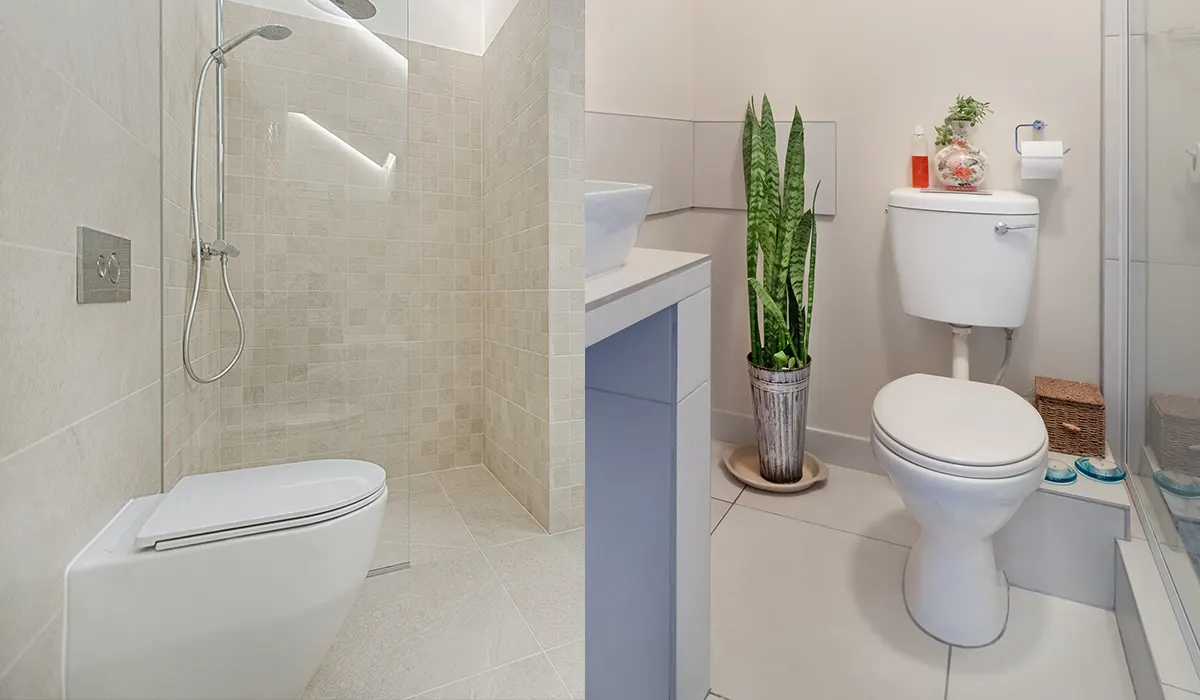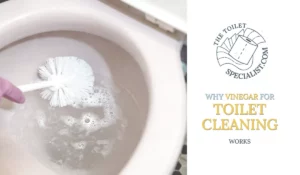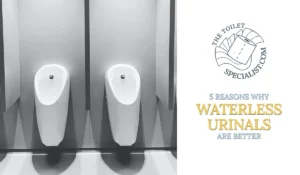If you’re about to buy a new toilet you’re probably wondering if a one or a two-piece toilet is better.
The biggest difference between one vs two-piece toilets is the way the tank is attached to the bowl. A two-piece toilet has its tank separate from the bowl. The tank is either bolted to the bowl, mounted to the wall, or behind the wall. A one-piece toilet has its tank and bowl fused together.
Two-piece toilets are the most common type of toilet in the US, but this doesn’t necessarily mean they are better.
Keep reading to find out more differences between one vs two-piece toilets and how to make the right decision on which one to buy!
What is the difference between a one vs two piece toilet?
A toilet exists out of two main parts:
- Toilet bowl
- This is the part you sit on to urinate and defecate in
- Toilet Tank
- This is the part that contains the water for flushing
The main difference between a one-piece toilet and a two-piece toilet is that a two-piece toilet either has its toilet tank attached to its bowl by using bolts or hung up against the wall or it has the tank built into the wall behind the bowl making the tank invisible. A one-piece toilet has the tank fused to the bowl.
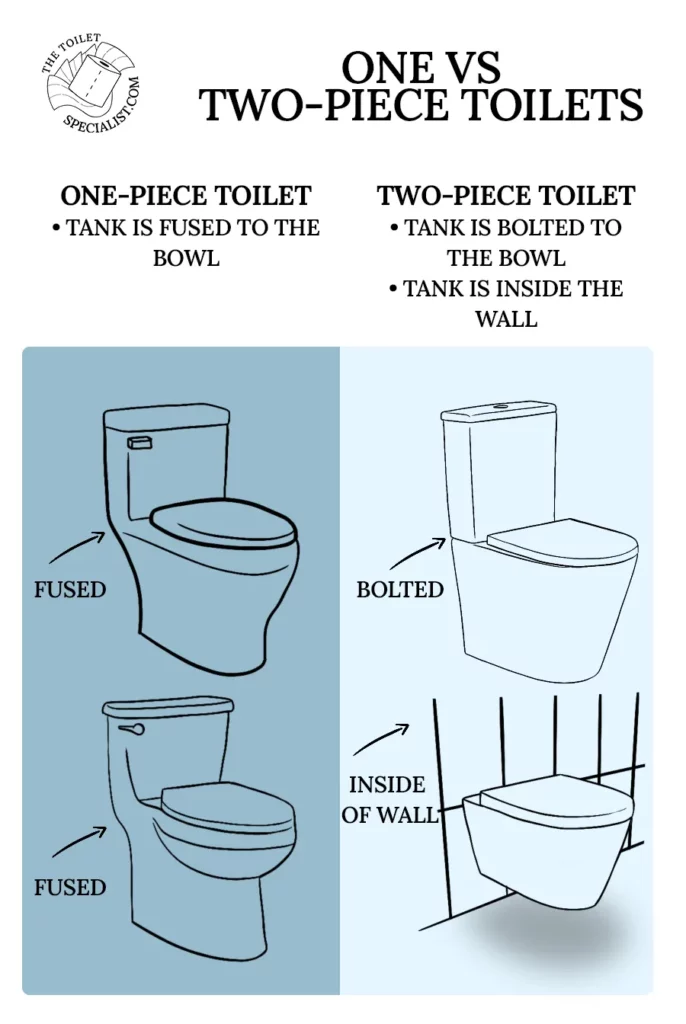
The benefit of having the toilet tank fused (one-piece) or bolted (two-piece) to the bowl is that if there’s anything wrong you have much easier access than if the tank would be inside the wall (two-piece).
But luckily it doesn’t happen often that you have to open the wall to reach the toilet tank to repair something.
So as you can tell, the main difference is the way the tank is attached to the bowl. But there’s more!
One-piece toilet
Since a one-piece toilet has its tank fused to the bowl, the toilet is bigger than a two-piece toilet that has its tank inside a wall. This means that small bathrooms don’t benefit from having a one-piece toilet as they take up more room than a wall-hung toilet (two-piece).
One-piece toilets always have the flush mechanism on the toilet (tank) itself and not on the wall.
Here’s an example of a one-piece toilet:
Benefits of one-piece toilets
So why would you consider buying a one-piece toilet?
Pros of having a one-piece toilet:
- Doesn’t need to be assembled
- Easier to clean than a two-piece
- Because the bowl and tank are fused together there aren’t any nooks and crannies you have to clean
- Looks modern because of its sleek design
Cons of having a one-piece toilet:
- They are more expensive than a two-piece toilet
- They weigh more than a two-piece toilet
- Due to the fact the tank is attached to the bowl and not separate
- If there’s a crack in either the bowl or tank you have to replace the entire toilet
Two-piece toilet
A two-piece toilet either has its toilet tank attached to the bowl by bolts or has its tank installed inside the wall behind it. When the tank is installed inside the wall the toilet takes up less space which makes two-piece toilets great for small bathrooms.
However, if you can’t build the tank directly into your wall for any reason (like when the wall is attached to your neighbour’s house), you can still have the tank inside a wall.
You need to extend the wall and put the tank in there. This way you also have extra room on top of that as seen in the example below:
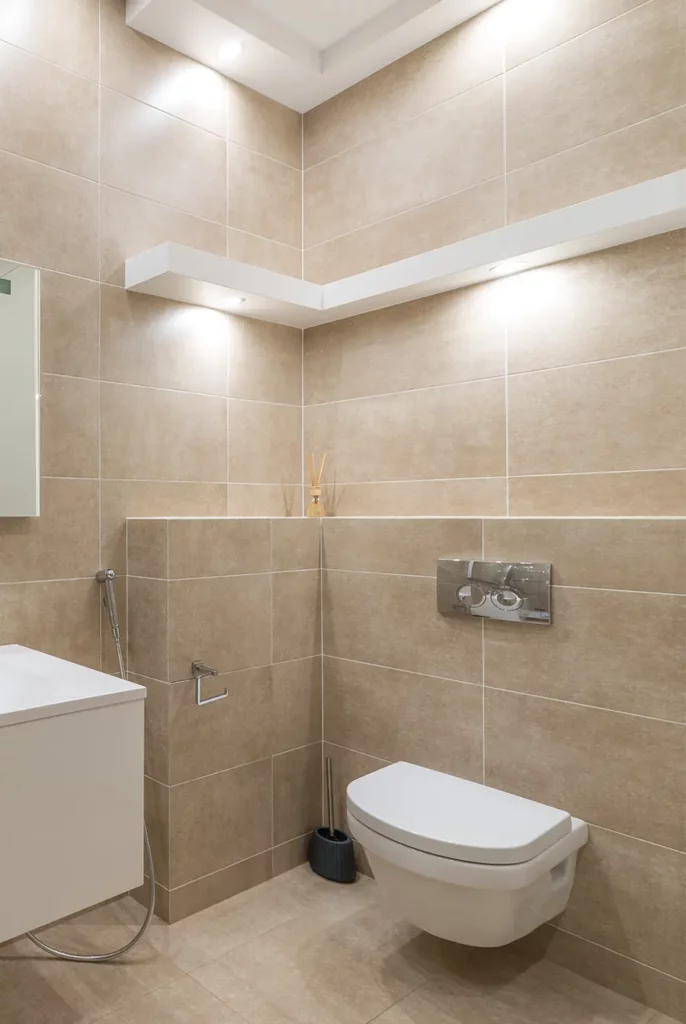
You may ask yourself why you want to do this as the new wall takes up space anyway. The reason is that you can then install a floating hung bowl. Which has the benefit that you can clean underneath it.
Floating bowls are only buyable as a two-piece.
Pros and cons of a two-piece toilet
So what are the pros and cons of a two-piece toilet?
Pros of a (wall-hung) two-piece toilet:
- If you have a wall-hung toilet it’s much easier to clean underneath it
- A toilet with its tank inside the wall has a modern look
- A two-piece toilet is lighter in weight which makes it easier to maneuver and thus install
- When the tank can be installed in the wall the toilet takes up less space
- Less expensive than a one-piece toilet
- You can easily adjust the height of a wall-hung toilet for when you grow older
Cons of a (wall-hung) two-piece toilet
- Installation requires extra time and effort because you need to open and install the water tank into the wall
- The nooks and crannies where the tank meets the bowl are harder to clean
- Some designs may look outdated
If you’re interested in learning more (funny) facts about toilets that may surprise you click here.
Keep reading to see a side-by-side comparison of one-piece toilets vs two-piece toilets.
One vs two-piece toilet comparison
The following table shows a clear view of the differences between a one-piece toilet and a two-piece toilet.
| One-Piece Toilet | Two-Piece Toilet | (Two-piece) Wall hung toilet | |
|---|---|---|---|
| Installing | Harder to maneuver due to the weight | Less complicated to install but may be harder because of the weight of the toilet | Harder to install b/c of having to open up the wall |
| Repairs/Maintenance | Parts are easier to replace because of easy access to the toilet tank | Parts are easier to replace because of easy access to the toilet tank | Parts are harder to replace because of the placement of the toilet tank in the wall |
| Cleaning | Easier to clean because of sleek design | Harder to clean because of nooks and crannies | Floor can be easily cleaned because there’s no contact |
| Visually | Modern | Some toilet can seem outdated | Modern and minimalistic |
| Water usage | Depends on tank settings | Depends on tank settings | Depends on tank settings |
| Costs | More expensive | Less expensive | Less expensive |
It ultimately comes down to whatever you prefer. The differences are so small that they can be neglected. This leaves aesthetics, cleaning, and budget to consider.
Price difference one piece vs two piece toilet
A one-piece toilet costs between $450-$1200 and a two-piece toilet costs between $250-$750. This is because producing a one-piece toilet is more complex which drives up the cost. Also transporting a one-piece will be more expensive because of the weight. One-pieces are heavier than two as everything is fused in the toilet.
However, when a two-piece tank cracks you can replace the tank alone. But when a one-piece tank cracks you need to replace the entire toilet which is more expensive.
Although two-pieces are slightly more prone to breakage than one-pieces.
Which is better: one-piece or two-piece toilet?
A one-piece toilet is not necessarily better than a two-piece toilet, and vice versa. Both have advantages and disadvantages that weigh each other out. This means that it all comes down to personal preferences.
The main thing to keep in mind is your space, budget, and whether you’d like to install it yourself.
Below you find the biggest pro and con of a one-piece toilet:
| Biggest PRO of a one-piece toilet | Biggest CON of a one-piece toilet |
| Easier to clean and doesn’t need to be assembled | When there’s a crack you need to replace the entire toilet |
Below you find the biggest pro and con of a two-piece toilet:
| Biggest PRO of a two-piece toilet | Biggest CON of a two-piece toilet |
| It’s cheaper than a one-piece toilet | Harder to clean because of the nooks and crannies |
Think about the reasons stated above and whether they are an issue for you.
In the United States, a two-piece toilet is the most common toilet used. This does not mean this type of toilet is better.
The probable reason a two-piece toilet is more commonly found in public areas and households is that two-piece toilets were cheaper and more heavily available back in the day. Since toilets last on average for about 20-50 years, the rise of one-piece toilets hasn’t caught up yet.
Can you replace a two-piece toilet with a one-piece toilet?
You can replace a two-piece toilet with a one-piece toilet, but be aware that the bowl is either the same size as the previous toilet or larger. If the bowl is smaller then you may have to redo your floors, as the previous bowl may leave marks.
This goes for every toilet you change.
Can you replace a one-piece toilet with a two-piece toilet?
You can replace a one-piece toilet with a two-piece toilet, but be aware that you may need to open up your wall to install the tank if you go for a wall-hung toilet.
Can I install a one-piece or two-piece toilet myself?
You can install a one-piece and or two-piece toilet yourself as long as you know a thing or two about plumbing. Nowadays you can find help ful online tutorials like the following ones:
One-piece toilet installation:
Two-piece toilet installation:
Wall hung toilet installation:
But if you want to be sure everything is properly installed, find a local plumber.
Bathrooms with one-piece toilet inspiration
Here’s a list of one-piece toilet inspiration for your bathroom:
For more toilet inspiration you can check out our Pinterest page.
Bathrooms with two-piece toilet inspiration
Here’s a list of two-piece toilet inspiration for your bathroom:
Frequently Asked Questions about one vs two-piece toilets
What is a one piece-toilet?
A one-piece toilet is a toilet that has its tank fused to the bowl making it easier to clean than a two-piece toilet.
What is a two-piece toilet?
A two-piece toilet is a toilet that has its tank separate from its bowl: it’s either bolted to the bowl, hung up against the wall or installed inside the wall behind the bowl.
What’s the difference between one vs two piece toilets?
The biggest difference between one vs two piece toilets is the attachment of the water tanks. With one-piece toilets, the water tank is fused to the bowl, and with two-piece toilets, the tank is bolted to the bowl or installed in the wall behind the bowl.
Disclaimer: TheToiletSpecialist.com is not responsible for any damage caused to your toilet by (wrongly) interpreting information found on this site. Please seek custom advice from a professional to evaluate your current situation.

